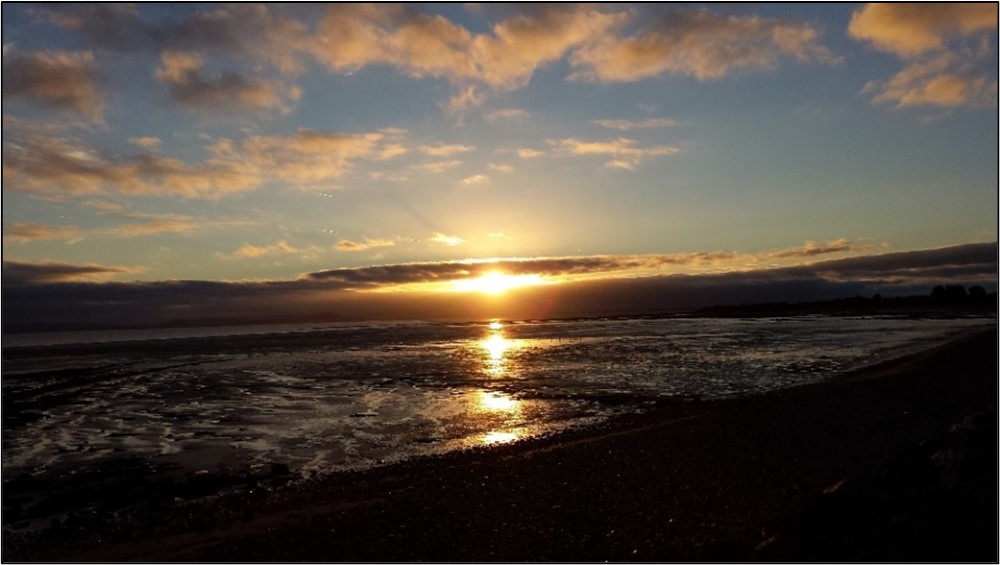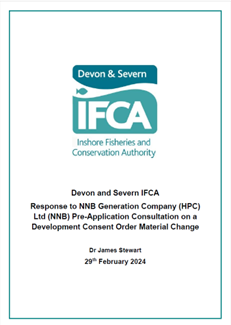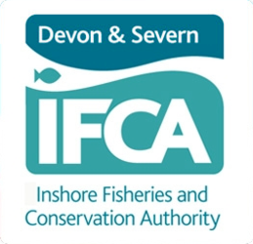D&S IFCA responds to EDF Consultation on Acoustic Fish Deterrent and Compensatory Habitat
D&S IFCA has identified the need for an Ecosystem Approach to the management of all activities in the marine environment, and therefore responds to consultations on marine developments in its District. D&S IFCA’s primary role in such matters is to ensure that fisheries, fish and fish habitat are considered thoroughly and meaningfully by marine managers and developers.

In 2013, NNB Generation Company (HPC) Ltd (NNB, part of EDF) was granted a Development Consent Order (DCO) authorising the construction and operation of a new nuclear power station in Somerset, known as Hinkley Point C (HPC). NNB plans to use water from the Severn Estuary (132 cubic metres of water per second) to feed the cooling system at HPC, taking water from submerged intakes located ~3 km from the shore at Hinkley Point. (Photo above – The Severn Estuary at low tide, as seen from Hinkley Point)
The DCO permission for HPC was originally granted with a condition that an Acoustic Fish Deterrent (AFD) was to be installed at the cooling water intake points, as part of a suite of mitigation measures designed to reduce fish kill by this system. NNB are proposing to make some changes to their DCO, and recently held a public consultation in order to gain feedback on their proposals. This consultation ran from 9th January to 29th February 2024.
NNB’s proposed changes include removing the requirement to install an AFD on the cooling water intakes, and NNB plans to take measures to “compensate” for the resulting harm to fish populations. Previous estimates by the Environment Agency have suggested that operation of HPC without an AFD will result in very large annual losses of fish from the Severn Estuary over the 60-year lifetime of the Project.
The fish populations that are vulnerable include the assemblage of fish species that are protected by the Severn Estuary Special Area of Conservation (SAC), and migratory fish species in the Severn Estuary SAC and nearby protected sites. Although the cooling water intakes are designed to be low velocity, this is not likely to stop many fish species from being entrapped in the system as they need a behavioural cue (e.g. sound from the AFD) to be able to avoid being taken in with the cooling water.

On 29th February 2024, D&S IFCA responded to NNB’s public consultation to outline its concerns about impacts on fish populations. The response was able to draw on D&S IFCA’s partnership work with scientists from a range of organisations, including Dr Thomas Stamp from the University of Plymouth, whose work has shown that recently-created compensatory saltmarsh (like that planned by NNB) does not fulfil the ecological role of established saltmarsh, and suggests that it may take many years for compensatory saltmarsh to be equivalent to natural saltmarsh for fish. D&S IFCA’s response was also able to build on recent data from a study of twaite shad, led by Swansea University. This study suggests that NNB may have underestimated the number of fish likely to be killed by the HPC cooling water intakes.
As a result of this and a range of other evidence, D&S IFCA argued that the compensatory measures planned by NNB do not go far enough to compensate for the harm likely to be caused by NNB’s proposals to remove the AFD. Though D&S IFCA recognises the important ecological role of saltmarsh and other coastal habitats, D&S IFCA also believes that compensatory measures, for harm caused to protected sites and species, should be more ambitious than those proposed by NNB in the recent consultation.
Among other issues, D&S IFCA also challenged some of the evidence used in NNB’s impact assessments, NNB’s case for continuing with their removal of AFD proposal despite evidence of likely harm to protected sites, and the suitability of NNB’s compensation and monitoring plans. The full consultation response is available to read on D&S IFCA’s website here.
Interested in our Environment & Research Work?
If you’re interested in our Environment and Research work, you can find some informative information in the D&S IFCA Environment & Research website display pages.
